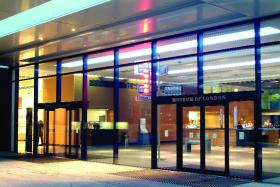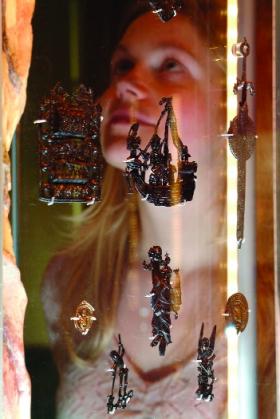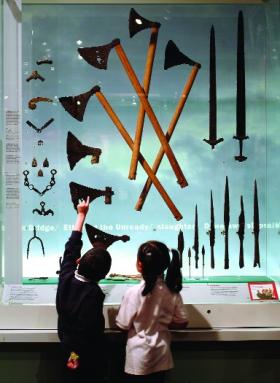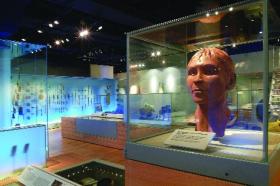Museum Eye
Published in Issue 2 (Mar/Apr 2007), Reviews, Volume 15
Front entrance of the museum.
Museum of London
150 London Wall, London EC2Y 5HN
+44 (0)870 443851
www.museumoflondon.org.uk
Mon.–Sat. 10am–5.50pm, Sun. 12 noon–5.50pm
by Tony Canavan
The Museum of London is housed in a relatively new building, specially constructed for it. In the spacious reception area you are greeted by a large satellite photograph of London, giving you an idea of the city’s size and shape. The museum itself consists of many galleries divided among sections corresponding to the main periods of the city’s history: ‘London before London’, the Roman gallery, medieval London, the early modern period, the twentieth century, and ‘World City’.
All the exhibits are well laid out and contain an attractive and entertaining mix of actual artefacts, reproductions and models. There is plenty of information for the visitor via both written panels and interactive screens. There is also an audio tour using headphones. One very good feature, and very popular with a school party during my visit, is the reproduction of artefacts that can be touched and examined alongside a display cabinet that holds the original objects. For example, in ‘London before London’, you can pick up replicas of worked flints, a Celtic sword and even the Dagenham Idol, a carved wooden object, as well as examining the real things in nearby cabinets.
The prehistory of London is an excellent archaeological exhibition of a time when aurochs and bison, whose skulls are on display, roamed the land on which the city was

Pilgrim badges on display.
built. As well as this there are the relics of human habitation and also the skeleton of ‘Shepperton Woman’, dating from 3640–3100 BC. Even in the distant past there were signs of what London would become in the form of early villages and the first bridge over the Thames, dating from the Bronze Age.
The real story begins with the Romans, who founded a city that was to be the capital of their province. This section is also chock-a-block with archaeological objects reflecting all aspects of life under the Romans, from sports and religion to food and trade. One surprising object was a pair of leather ‘bikini’ bottoms worn by a female performer in the circus. I was especially impressed when looking at a display on Londinium’s Roman wall to glance out of a nearby window and see a fragment of the wall itself still standing after almost 2,000 years. You can also see the skeleton and sarcophagus of the ‘Spitalfields Roman’, a woman who died of an unknown disease in her twenties.
The information presented and the narrative of the city’s history that takes shape here reflects how modern London sees itself. The Roman Empire is described as an early ‘European Community’, and there is emphasis on the multi-ethnic make-up of London and its importance as a world trade centre (just like today, the panels all but say). The idea of Londinium being a metropolis is further emphasised by the reproduction of Roman rooms and workshops, some of which appear to be modern in style. The recreation of rooms from different periods is a very strong feature of the museum and really brings home to the visitor that this is an urban history.
The idea of London as a cosmopolitan centre of world trade is carried on throughout the museum. After the hiatus of

Viking weapons.
(All images: Museum of London)
the Saxon invasion, the timeline resumes with the story of the city as a centre of trade and manufacture. The ‘political’ aspects of the history, whether Norman invasion or the Wars of the Roses, are almost ignored as the growth of the city and its commerce is celebrated. This continues on through the various historical periods, and, where we might have expected the story of London to be the story of the nation, this is not the case. While the international aspect of London is explored and celebrated in detail, its role as the capital of England and seat of government is mentioned only in passing.
This is not altogether a weakness in the museum since London is one of the world’s great metropolises and there is a wealth of material on its citizens, its streetscape and industry. This is impressively reflected in the various galleries, where contemporary comment is balanced by historical perspective, and every gallery is a treasure-house of tools, weapons, costumes, paintings and so on. There is not enough space here to do justice to everything, but some things are worth mentioning. The Cheapside Hoard of wealthy Londoners’ jewelry dating from 1560 to 1640 deserves some attention. The ‘Great Fire Experience’ about the fire of 1666 is one that will appeal to visitors of all ages. A diorama uses lights and sound effects to tell the story of how four-fifths of the city was burned to the ground in a few days. The collection of costumes and scientific instruments from the eighteenth century is eye-catching. Through architectural drawings and models we see the city take its present aspect in the 1700s as the great squares and thoroughfares were laid out.
The final section, World City, celebrates London as the capital of the British Empire, although the tag ‘imperial’ is not used. As well as all the machines, steam engines and memorabilia, it is worth checking out the recreation of a Victorian street, which includes a pub serving Dunville’s Irish Whisky. One person quoted said that London at this time had ‘more Scotchmen than in Edinburgh, more Irish than in Dublin, more Jews than in Palestine and more Roman Catholics than in Rome’. Quite a boast! The story is taken up to the First World War but seems to end rather abruptly. I was eager to find out about the history of London in the twentieth century as well.

‘London before London’.
I left very impressed. It is a great museum in terms of size, presentation and collection. It takes a few hours to do it justice and I certainly appreciated the chance to sit down in the museum café afterwards. And as I drank my coffee, I could not help but feel envious and regret that our own capital city, Dublin, does not have a museum on this scale devoted to its history.
Tony Canavan is a former Museum Officer of Newry and Mourne District Council.
















